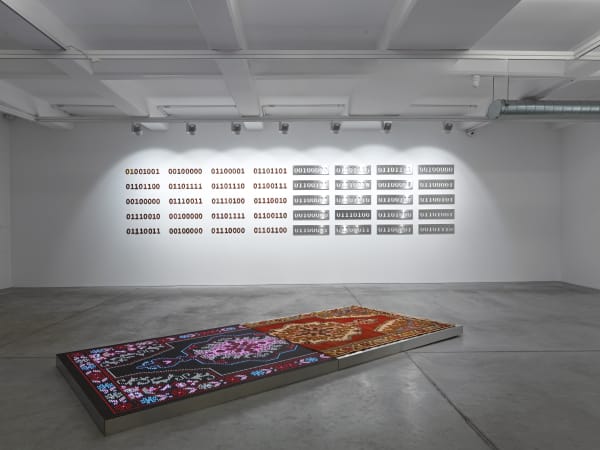Cem Sonel and Ramazan Can Turkey
Born in Ankara in 1985, Sonel completed his undergraduate education at Hacettepe University, Faculty of Fine Arts, Graphic Design Department with an honorary degree. In 2009, he succeeded in bringing to life his childhood interest in street art, by co-founding the street art collective (KÜF Project). The guerrilla street art actions they carried out with the collective between 2009 and 2014 were the subject of many news bulletins in the mainstream media. In 2014, he was accepted to the Sculpture Master’s Program at Hacettepe University Fine Arts Institute. Moving his workshop to Izmir-Darağaç in 2017, he continued to work both individually and with the neighborhood art collective.
Sonel's works have been exhibited in many national and international organizations such as Berlin Art Week, Contemporary Istanbul, Sónar Festival, 48 Stunden Neukölln. He organized workshops on street art in many universities of Turkey, was invited to panels as a speaker, and directed sessions.
He introduced the first semi-digital Mural works in Turkey to the public audience at the mural festivals held in Istanbul, Ankara and Izmir. He still continues his research on the meeting of new media art with street art.
In 2022, he held his first solo exhibition titled "One and Zero Makes Two" at the Anna Laudel gallery in Istanbul.
Since 2020, he has been continuing his art and design productions in his workshop in Ankara.
Born in 1988 in Manisa, Ramazan Can graduated from the Department of Fine Arts Education, Faculty of Education, Gazi University in 2011. He completed his master’s degree in the Department of Painting at the Institute of Fine Arts, Gazi University in 2015, and re- ceived his Proficiency in Arts degree from the same department in 2023. Currently, he is continuing his Pro- ficiency in Arts program in the Department of Sculp- ture at the Institute of Fine Arts, Hacettepe University, while also working as a Lecturer in the Department of Painting at Ankara Hacı Bayram Veli University’s Fac- ulty of Fine Arts. He continues his work in his studio in Ankara.
Shamanism and modern mysticism play an important role in Ramazan Can’s works. Although he frequently uses Anatolian motifs, he approaches these motifs dis- tantly, blending them with neo-expressionist elements and detaching them from their historical context. His works, which encompass a wide variety of disciplines such as painting, collage, neon light installations, and sculpture, display great diversity. With works featured in prestigious collections, he has gained international attention and held solo exhibitions at Villa Merkel and Gustav-Lübcke Museums. His works, while political, convey deep narratives and reflections on history and modern society.
Artist Statement: Ramazan Can & Cem Sonel
We, Ramazan Can and Cem Sonel, merge the narratives born from our individual artistic journeys into a shared creative universe. Our art explores the layers of memory, the cyclical flow of time, and the fabric of collective consciousness through the rhythm of the contemporary world. At the intersection of tradition and modernity, material and digital, our mediums form a “third identity”—one that belongs neither solely to one of us, but emerges from the union of both.
As Ramazan Can, I draw inspiration from the ancient motifs of Yörük culture and the rhythmic geometry of woven carpets. The warp and weft of my weavings collect the building blocks of memory in geometric order; when combined with the cold surface of concrete, they carry the warmth of the past into the sharp reality of the present. Cem Sonel, on the other hand, questions existence through the language of technology. The pixel pulse of LED panels, the algorithmic structure of computer code, and the vibrancy of neon paint together map the meaning of the modern age in his work. The grid structure of my weaving enters into a dialogue with the mathematical aesthetics of Cem’s digital screens; this encounter builds a bridge from personal memories to collective consciousness.
Our works reflect the harmony of opposites: the warm texture of the carpet blends with the cold surface of concrete; the abstract logic of code merges with the brightness of neon. This fusion whispers that time is not linear, that the past and future are interwoven. Mathematics and algorithms form the invisible backbone of our works, while the rhythm of weaving and the logic of code transform the dance between tradition and technology into a universal narrative. Our art invites the viewer not only to observe, but to reconstruct their own journey through memory.
Together, we create a space where analog and digital converge. By pushing the boundaries of materials and ideas, we combine elements such as carpet, concrete, mosaic, LED, and code—not in conflict, but in a new visual and conceptual unity. This process compels us to move beyond our individual identities and redefine ourselves; we observe our work with a critical distance and become part of an ever-evolving creative dialogue. Our art carries the knowledge of the past into the future and invites the viewer to join this timeless journey.

